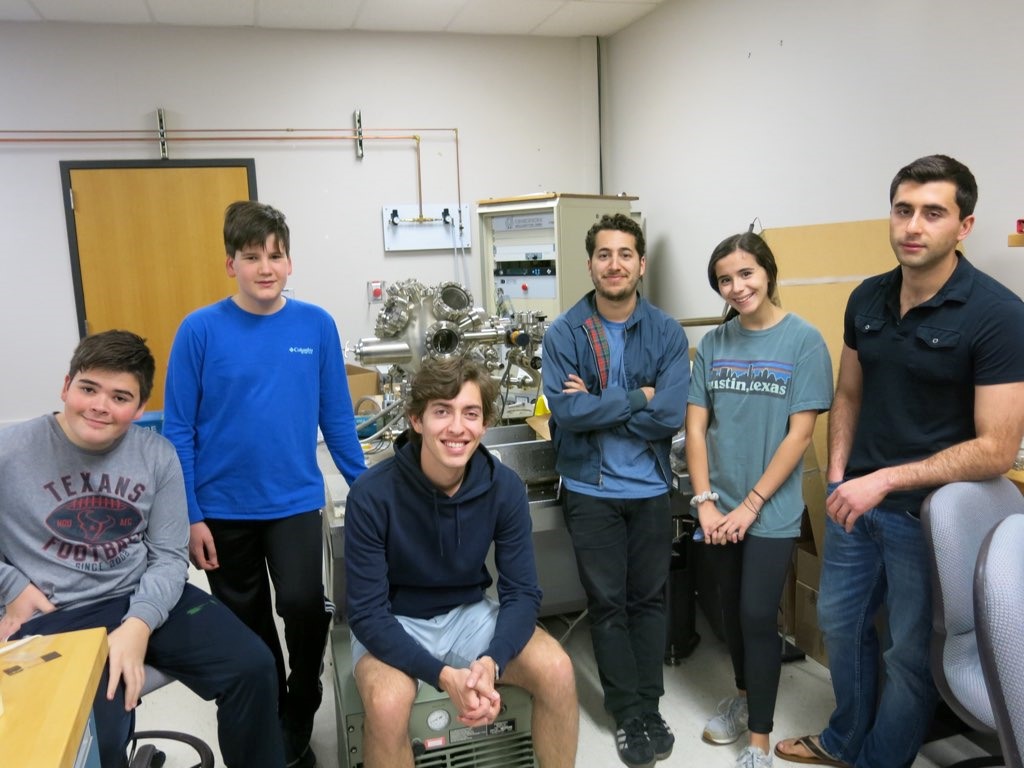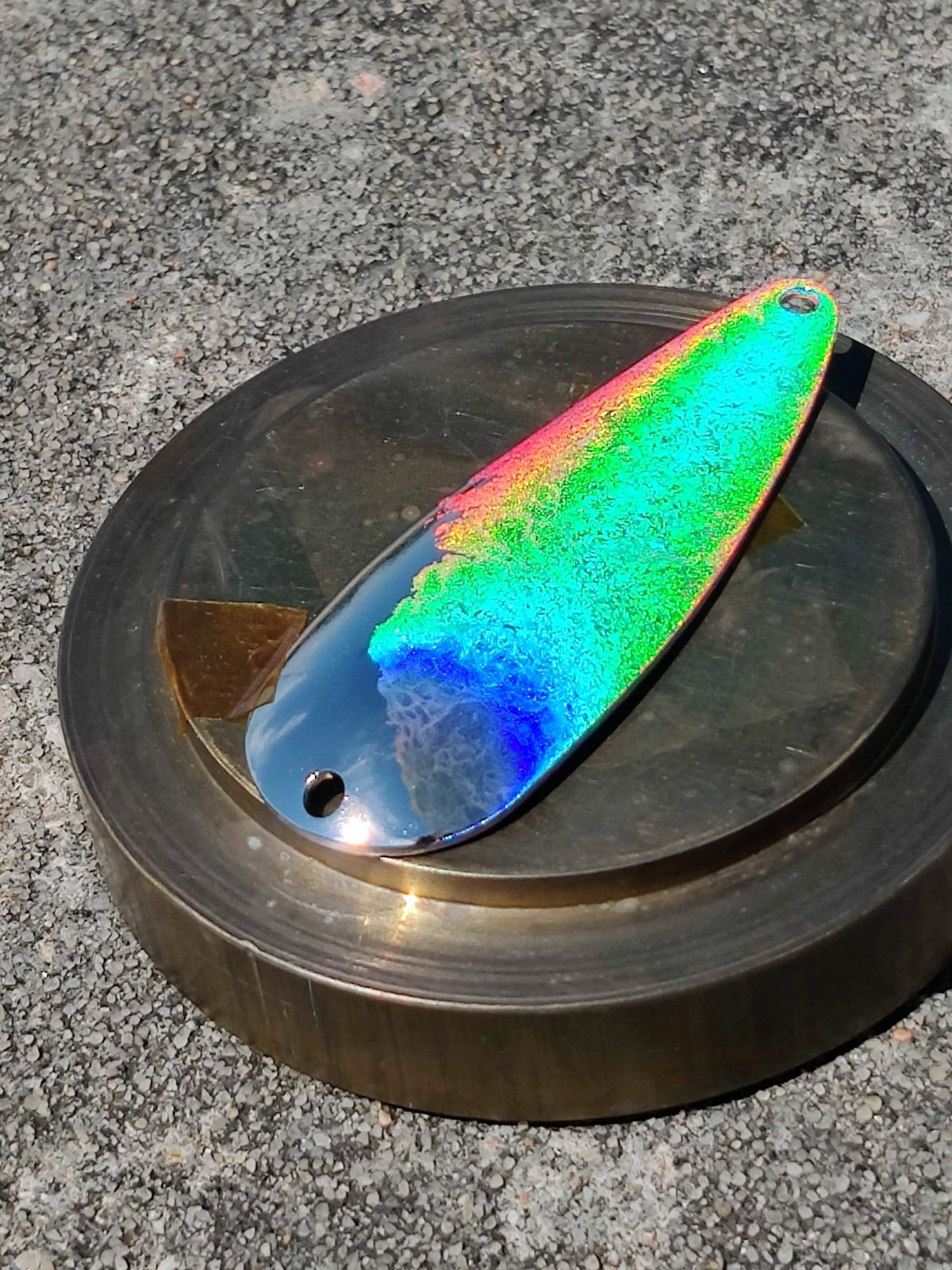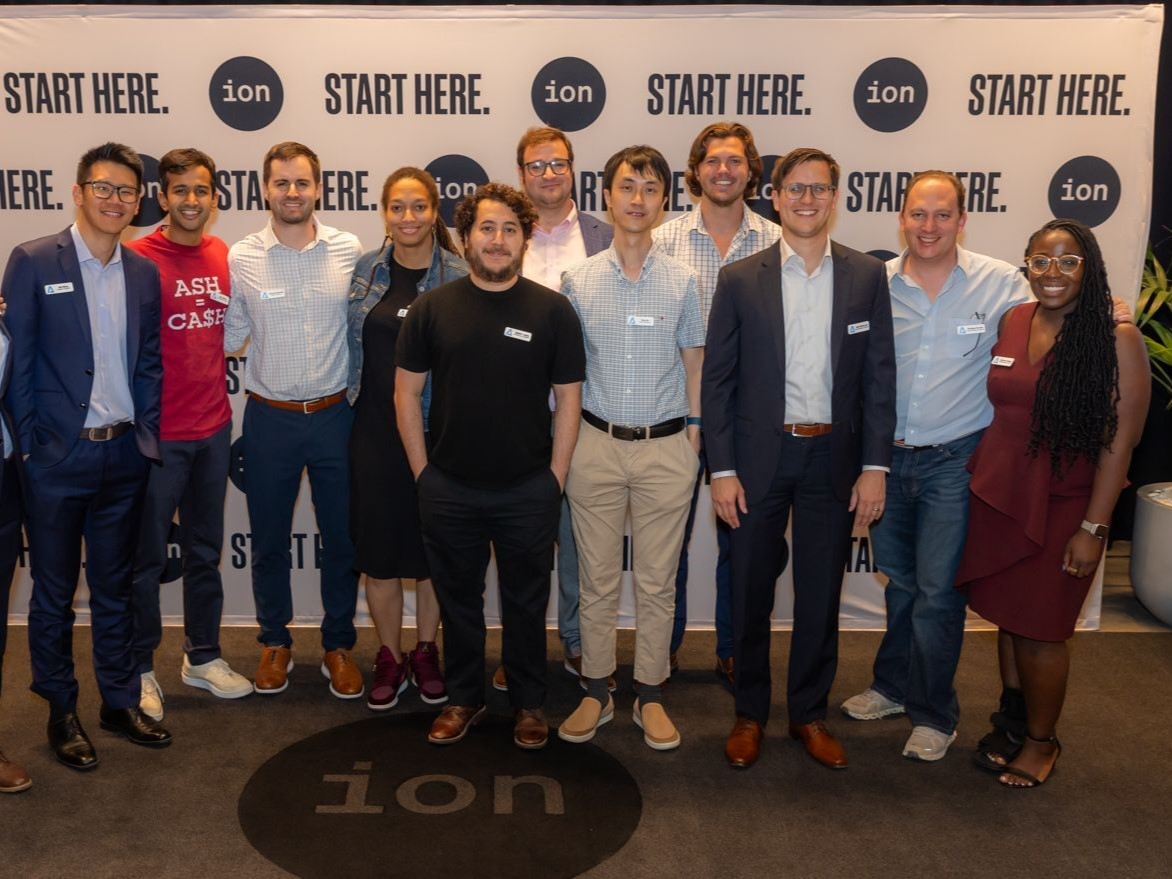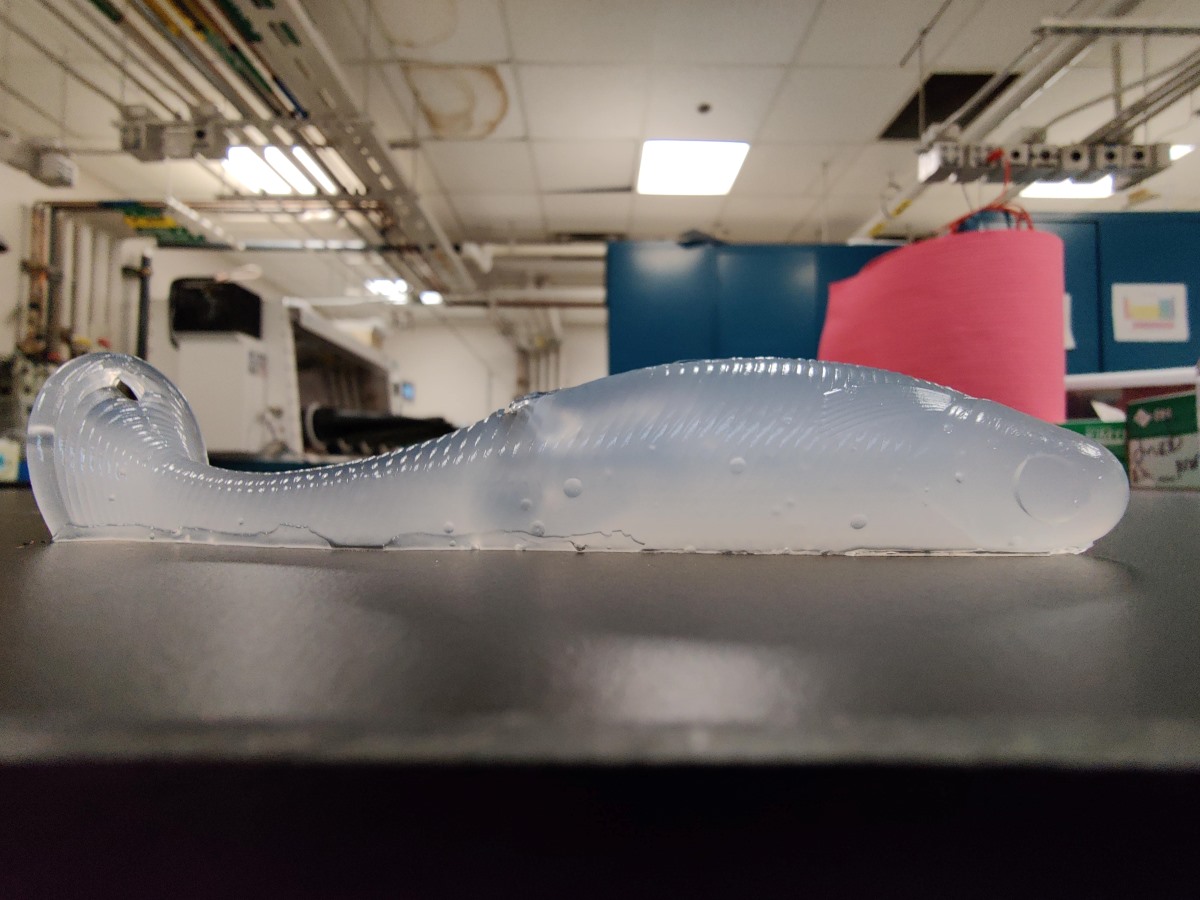
Texas Engineer Gabriel Cossio gives high school students a tour of his lab.
Nanotechnology – the ability to control materials all the way down to the molecular level – is transforming industries around the world, including agriculture, renewable energy, food, cosmetics, medicine, healthcare, automotive, oil and gas industries and chemicals. However, despite its growing popularity, the costs and labor behind developing nanotechnology keep it out of reach for all but the biggest companies.

A fishing lure made by Gabriel Cossio’s startup company.
Enter Gabriel Cossio and his new startup, Nanoscale Labs. Born out of graduate research, the company aims to lower the costs of nanotechnology, making it more accessible for protecting and maintaining the environment. Two early examples of this work are the development of materials for more efficient solar panels and environmentally friendly fishing lures.
For Cossio, it is personal as well. He grew up in Bolivia near lake Uru Uru, a once-thriving waterway that today is bereft of aquatic life. After decades of pollution from industrial waste and trash from the city center, it is sadly home to more plastic than water.
Plastic fishing lures play a major role in polluting our waters. This fact, along with a somewhat underserved market, made fishing lures an intriguing first target for the company.
Cossio is a postdoctoral fellow in Ed Yu’s lab. Yu is a professor in the Chandra Family Department of Electrical and Computer Engineering and leader of the Center for Dynamics and Control of Materials. Cossio was recently named UT’s first Activate fellow, joining a prestigious group of 61 other scientists and engineers who were selected out of more than 1,000 of the nation’s top researchers. The fellowship is focused on helping scientists take breakthrough deep-tech innovations to the market.
Read on to learn about how Nanoscale Labs came to be, how the fellowship will take it to the next level and his advice for budding entrepreneurs.
Tell us about the idea behind Nanoscale Labs and the problems it aims to solve?
Nanoscale Labs was born out of science more than my desire to start a company. As a graduate student, I was working on a research project that aimed to decrease the cost of a class of solar materials called III-V photovoltaics and improve their power conversion efficiency using nanoparticles.
For decades, scientists have struggled to implement the nanotechnology technique we use on a large scale, and this project was no exception. But I couldn’t let it go. I continued to work on the problem and eventually cracked the code.
I was pretty stunned at the results, which showed we were getting over 100x the efficiency of previous state-of-the-art techniques. After seeing the amazing results, I knew I had to try to commercialize this.
Nanoscale Labs has two main goals that will open up nanotechnology to a wide variety of applications and users. The first is to lower the financial barrier to creating nanotechnology. And number two, once we can manufacture more cost-effective nanotech, we want to leverage our nanomanufacturing capacity to commercialize products that better the environment.
For example, one of the products we’re developing is a type of nanotextured glass that allows solar panels to absorb more light and create more electricity. Nanotextured glass for solar panels has been around for decades – but it’s always been far too expensive to manufacture for real-world implementation. Our tech lets us make nanotextured glass to improve solar efficiency at a significantly lower cost.

What do you do differently compared to what’s out there today?
Not to sound too presumptuous, but there really isn’t anything out there that’s like what we’re doing. Our technology will essentially unlock the door for entirely new markets to leverage advances in nanotechnology – particularly markets that need to maintain affordable products.
Traditionally, commercialized nanotech has only existed in the semiconductor industry, which is dominated by tech giants (think: Intel, Samsung, TSMC, Apple, etc). These companies have deep enough pockets to spend hundreds of millions of dollars on tooling, infrastructure, materials and engineering teams to create and launch products on a massive scale. This means that even though there are already proven nanotechnologies to make solar panels more efficient, for example, solar manufacturers can never incorporate these technologies because the added capital costs to implement them would put them out of business.
One of your first products will be sustainable fishing lures. Why fishing lures?
Surprisingly, the fishing lures market is a great beachhead for us for a few reasons. First, the U.S. fishing lure market is quite large ($4 billion by 2030) but not nearly as large as other markets we are interested in such as solar ($95 billion by 2030). By starting with fishing lures, we’ll be able to gain revenue while also demonstrating our technology can scale. This will lower commercial and technical risk for investors if we choose to raise venture capital funds that may be useful to accelerate our entry into larger markets like solar panel technologies.
Second, it turns out that fishing lures are extremely toxic and a main source of aquatic pollution in American fisheries. Today, almost all soft fishing lures are made from carcinogenic plasticizers called phthalates, and roughly 10,000 tons of them are lost in fisheries annually. Phthalates are EPA-recognized endocrine disruptors that have numerous negative long-term health consequences for both humans and aquatic plants and animals.
Also, phthalates easily leach out of lures and bioaccumulate in fish – which many anglers are unaware of when they catch fish to eat. In addition to the toxicity of soft lures, the painting of hard lures releases tens of thousands of tons of volatile organic compounds (VOCs) per year, which are powerful greenhouse gases with long-term human health consequences.
Our nanotech completely eliminates both of these environmental and human health problems. It turns out that vibrantly colored animals like fish, insects, peacocks, etc leverage nanotechnology to create what’s called “structural color,” i.e., color that arises from tiny nanopatterns instead of from dyes or pigments. We’ve found a way to use nanopatterning to replicate this biomimetic coloring in a manner that releases zero VOCs.
We also leveraged other nanotech tricks to develop biopolymers to replace the carcinogenic plastics used to make soft lures. These biopolymer soft lures have numerous never-before-seen functionalities, like improved mechanical strength and self-healing properties that enable repair of damaged lures by simply pressing together the damaged pieces. Both the nanopatterning and the biopolymer are 100% non-toxic and sustainably manufactured. In fact, the biopolymer is mostly made out of naturally derived ingredients like molecules extracted from seaweed.

A fishing lure made by Gabriel Cossio’s startup company.
How will the Activate fellowship help you and your company?
Activate offers two main resources to help startups get off the ground: financial support for staffing and research and a vast community of potential partners and collaborators.
Funds that pay for the fellow’s salary help give the company some financial breathing room. Since you usually still have a full-time job, trying to simultaneously launch a business creates incredible stress and financial pressure. Couple this with a severe lack of time and it can lead to some poor decision making early on – such as agreeing to bad terms for an initial investment or sacrificing your personal health or community to try and have enough hours in the day to get everything done.
Research and development funds help de-risk your tech. The more time you’ve spent doing that, the stronger you’ll be when trying to raise venture capital or need to show preliminary data for government grants.
The Activate community is a vast network that helps its founders level up. It’s shocking to me that within two conversations, I can get in contact with someone who was a clean energy advisor to the Obama administration or receive a warm intro to most of the venture capital groups relevant to my applications.
Beyond networking, the community of like-minded scientists-turned-entrepreneurs is priceless. Through Activate, I’m surrounded by incredibly smart people throwing all their energy at some of the world’s most important problems. Not only is that super inspiring and energizing, but these people are also always interested in talking, brainstorming and troubleshooting problems together, which makes every scientific and business obstacle feel much less imposing.

Tell us about an influential moment/course/project/person at UT, and how it helped shape your work?
I’m not a person who always wanted to be an entrepreneur. My main motivation in undergrad and grad school was simply to learn cool and interesting things.
However, I do remember being particularly influenced by S.V. Sreenivasan’s class on nanotechnology during my Ph.D. coursework. In this class, he helped us understand that even if you create an amazing technology that say, for example, creates a cure for cancer, that technology will never see the light of day if you can’t make it affordable or if it doesn’t scale well.
Another inflection point came when I got a chance to do research as an undergrad – low and behold, I did my undergraduate, Ph.D. and postdoc at UT (Hook ‘em!) – in Elaine Li’s lab. Elaine was a great mentor who made me realize I had a lot left in the tank academically. As an undergrad, I did not try as hard as I could have (and should have). Having Elaine as a mentor was really important in helping me live up to my potential.
What advice would you give to entrepreneurial students at UT and elsewhere?
I think my best advice is to be well rounded, pursue fulfilling experiences and be infinitely curious. If you’re really interested in a microbiology class or art history class but you’re an aerospace engineer, go for it!
The entrepreneurial space moves so fast. If you launch a startup, you’ll feel like you’re drinking from a fire hose. A broad knowledge base will help you see patterns in the chaos and aid you in making good decisions.
Similarly, having many fulfilling experiences will help you understand, work well and collaborate with other people who may be able to provide help, resources or important contacts in the future. What many people don’t realize is that being a successful entrepreneur is as much about luck, timing and being personable as it is about having great technology.
Being curious, well-rounded, and genuine will help you take advantage of lucky encounters and seize opportunities that seemingly pop up out of nowhere.
